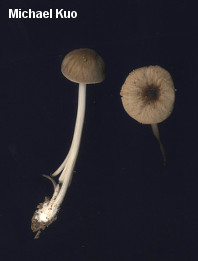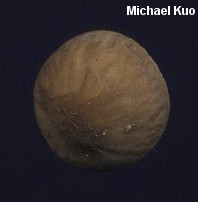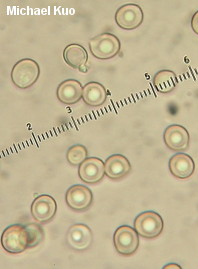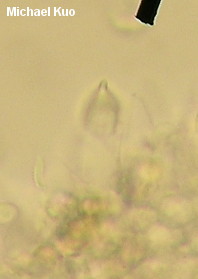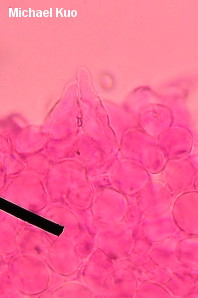| Major Groups > Gilled Mushrooms > Pink-Spored > Pluteus > Pluteus thomsonii |

|
Pluteus thomsonii [ Basidiomycota > Agaricales > Pluteaceae > Pluteus . . . ] by Michael Kuo As it is currently defined, Pluteus thomsonii is a small, brown-capped species of Pluteus with a cap surface that often becomes elaborately veined. Under the microscope, its cheilocystidia are "rostrate" (featuring a single, finger-like to beak-like apical projection). Microscopic examination is probably necessary to confirm identification, since several species of Pluteus can occasionally develop veined cap centers but do not feature rostrate cystidia. Field guide authors (myself included), under pressure from publishers to provide attractive illustrations, often choose photos of dramatically veined Pluteus thomsonii specimens--but Homola (1972) points out that "the extent of the reticulate venations of the pileus varies considerably in P. thomsonii. In larger specimens the venation is very prominent and conspicuous and in smaller, mature specimens it may be absent." There may be several species passing as Pluteus thomsonii; according to Minnis & Sundberg (2010), "[a] critical re-evaluation of Pluteus thomsonii is needed on a worldwide basis to determine if cryptic species are present." "Pluteus thompsonii" (with a P) is a misspelling propagated by a typo in Smith, Smith & Weber (1979). Description: Ecology: Saprobic on decaying hardwood logs and debris; growing alone or gregariously; early summer through fall; widely distributed in eastern North America, and documented in California. The illustrated and described collections are from Illinois. Cap: 1-3 cm across; convex at first, becoming broadly convex, usually with a central bump, or nearly flat; dry; dark gray-brown when young, fading to dull grayish brown with a darker disc; usually featuring a wrinkled or veined (sometimes elaborately) center, but occasionally smooth. Gills: Free from the stem; close; short-gills frequent; whitish at first, becoming pinkish. Stem: 3-5 cm long; 1-4 mm thick; equal; fragile; bald or silky; whitish, becoming gray to brownish from the base upward. Flesh: Insubstantial; whitish; unchanging when sliced. Odor and Taste: Not distinctive. Spore Print: Pink. Microscopic Features: Spores 5-7 x 5-6 µ; broadly ellipsoid to subglobose; smooth; hyaline and uniguttulate in KOH. Pleurocystidia rare and scattered; utriform to widely cylindric or sublageniform; thin-walled; hyaline in KOH; to about 35 x 11 µ. Cheilocystidia lageniform to subutriform or mucronate; often rostrate with a small to long mucro; thin-walled; hyaline in KOH. Pileipellis a cystoderm with subglobose as well as cystidioid elements; brownish in KOH. REFERENCES: (Berkeley & Broome, 1876) Dennis, 1948. (Saccardo, 1887; Homola, 1972; Smith, Smith & Weber, 1979; Vellinga, 1990; Breitenbach & Kränzlin, 1995; Roody, 2003; Minnis & Sundberg, 2010; Justo et al., 2011; Kuo & Methven, 2014.) Herb. Kuo 07100304, 07290303, 07300906. This site contains no information about the edibility or toxicity of mushrooms. |
© MushroomExpert.Com |
|
Cite this page as: Kuo, M. (2015, June). Pluteus thomsonii. Retrieved from the MushroomExpert.Com Web site: http://www.mushroomexpert.com/pluteus_thomsonii.html |
